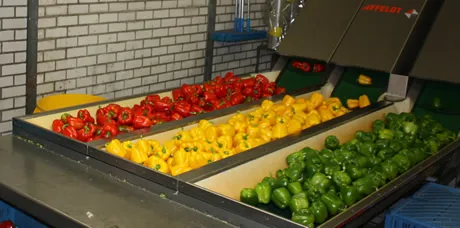 The Dutch bell pepper season got off to an interesting start. Not because of the acreage, because that was virtually unchanged from last year, but because of the cold spring weather; which caused production to start much later than in previous years. "The interesting thing was that the Spanish season ended early and Israel dropped out early because of quality problems. This resulted in good prices at the start of the season. Until two weeks ago we had pretty good prices, but because the kilos were coming in much later, things are not so great anymore," says project leader Thijs Jasperse from the P-8. "The harvested kilos are still behind last year. Now you are seeing that extra things are coming onto the market because the bell peppers only come once from the plant. This is resulting in prices around one euro."
The Dutch bell pepper season got off to an interesting start. Not because of the acreage, because that was virtually unchanged from last year, but because of the cold spring weather; which caused production to start much later than in previous years. "The interesting thing was that the Spanish season ended early and Israel dropped out early because of quality problems. This resulted in good prices at the start of the season. Until two weeks ago we had pretty good prices, but because the kilos were coming in much later, things are not so great anymore," says project leader Thijs Jasperse from the P-8. "The harvested kilos are still behind last year. Now you are seeing that extra things are coming onto the market because the bell peppers only come once from the plant. This is resulting in prices around one euro.""From P8 we have have identified some notable market developments, such as the price war that is going on in the retail world. At P8 we have said the prices of our products were too high in the supermarket, but gradually we can say that the prices are too low. That is happening in Aldi and Lidl, our major markets. Not only have the margins been reduced for supermarkets, but our product has also become less valuable. In terms of bell pepper consumption, Germany has always been on top and the Netherlands is a close second. The United Kingdom is far behind, but due to the price decrease paprika consumption is rising," says Thijs.

"Another trend is that the red, yellow, green paprika's, that have been world famous for twenty-five years, are under pressure. The question is whether these bell peppers will still exist in ten years, and what implications this will have for the green bell pepper. The green bell pepper is bought when in the red, yellow, green 3 pack, but is rarely bought separately, while the red bell peppers is the most popular. We will have to be creative. There are enough chances, but we need to get started," says Thijs.
